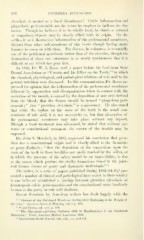Page 510 - My FlipBook
P. 510
508 PYORRHEA ALVEOLARIS.
nlveohiris is trentotl as a local disturbance.^ Calcic inflaimiiation and
phagt'donic [XM'iccnicntitis are the terms he employs to indicate its cha-
racter. Thouoh he believes it to be wholly local, he thinks a serumal
or sanguinary deposit may be closely allied Avith its origin. He de-
scribes it as a destructive inflammation of the pericemental m(>mbrane,
distinct from other iirtlammations of this tissue though having many
features in common with them. The disease, he estimates, is essentially
one of the peridental membrane rather than of the alveolus, though the
destruction of these two structures is so nearly synchronous that it is
difficult to say which has gone first.
In 1886, Dr. W. J. Reese read a paper before the Louisiana State
Dental Association on " Uremia and Its Effect on the Teeth," ^ in which
the chemical, physiological, and pathological relations of uric acid to the
general nutrition were discussed. In this communication Dr. Reese ex-
pressed the opinion that the inflammation of the pericemental membrane
followed by suppuration and disorganization when in contact with the
secretions of the mouth, is caused by the deposition of uric acid derived
from the blood ; that the disease should be termed " phagedena peri-
cementi ; " that " pyorrhea alveolaris " is a misnomer. He also stated
that while the tophus on the roots of the teeth is the usual con-
comitant of uric acid, it is not necessarily so, but that absorption of
the pericemental membrane may take place without any deposit.
Though a local treatment was advocated, he stated that without sys-
temic or constitutional treatment the return of the trouble may be
expected.
Dr. John S. Marshall, in 1891, expressed his conviction that pyor-
rhea has a constitutional origin and is closely allied to the rheumatic
or gouty diathesis ; *' that the deposition of the concretions upon the
roots of the teeth in those localities not easily reached by the saliva, or
in which the presence of the saliva would be an impossibility, is due
to the causes which produce the chalky formations found in the joints
^
and fibrous tissues of gouty and rheumatic individuals."
The writer, in a series of papers published during 1892-94-95,^ pre-
sented a number of clinical and pathological facts which in their totality
it was believed established a kinship between pyorrhea alveolaris or
hematogenic calcic pericementitis and the constitutional state familiarly
known as the gouty or uric acid diathesis.
Recent literature by American writers has dealt largely with the
1 " Diseases of the Peridental Membrane having tlieir Beginning at the Margin of
the Gum," American System of Dentistry, vol. i. p. 953.
^ Dental Cosmos, vol. xxv. p. 550.
•^ " The Rheumatic and Gouty Diathesis, with its Manifestations in the Peridental
Membrane," Trans. American Medical Association, 1891.
* International Dental Journal, vols, xiii., xv. and xvi.


